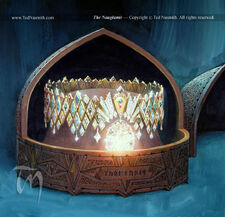The Nauglamír was a Dwarven necklace in the First Age; it played an important role in the final parts of the Narn i Chîn Húrin.

History
After Húrin brought the treasures of Nargothrond to Doriath, Thingol summoned Dwarves of Belegost to Menegroth and invited them to work the treasure into jewelry. The finest of these pieces became the Nauglamír.
It was the second-greatest treasure of Doriath, prized above all except Beren and Lúthien's Silmaril. After the smiths of Belegost finished their work on the Nauglamír, Thingol requested that the Dwarves of Nogrod set the Silmaril in it. The Nauglamír, now bearing the Silmaril, was held to be the fairest object in Arda.
Enthralled by its beauty and greedy for the Silmaril, the Dwarves demanded the necklace, insisting that as Dwarf work it belonged to them. Thingol was unwilling to surrender the treasure and replied with an impertinent answer. In their anger, the Dwarves slew him, after which most of the party were slain by the king's guards. Two escaped to Nogrod and told a much different story to their kinsmen, persuading the city to march on Doriath.
After the battle in the Thousand Caves, the Dwarves of Nogrod marched homewards with the stolen Nauglamír and the rest of the treasures of that land, but Beren, at the head of an army of Laiquendi and Ents, destroyed the Dwarf army at the Battle of Sarn Athrad. The treasure was cast into the Ascar, save the Nauglamír, which Beren gave to Lúthien.
After Beren and Lúthien's final deaths, the necklace was inherited by their son, Dior, who became the second King of Doriath. When the Sons of Fëanor heard of this, they demanded that he surrender it to them or become their enemy. His refusal brought about the Second Kinslaying as the Sons of Fëanor, seeking the Silmaril in accordance with the Oath of Fëanor, attacked Doriath. Dior's daughter, Elwing, escaped the kinslaying with the Nauglamír, fleeing to the Mouths of Sirion.[1]
In the Third Kinslaying, the Sons of Fëanor attacked the Elven Havens of Sirion, still trying to obtain the Silmaril within the Nauglamír; however, Elwing cast herself into the sea with it rather than surrender the gem to Maedhros and Maglor. The Nauglamír was lost, but Elwing and the Silmaril were saved by the ValaUlmo.[2]
Other versions of the legendarium
In an earlier myth of First Age lore that preceded the final stories in The Silmarillion, namely the Lost Tale The Nauglafring, the Nauglamír (named the Nauglafring) is more important: the necklace becomes caught behind a tree branch when Thingol is riding outside the Girdle of Melian and is attacked by the Dwarves. Thingol is unhorsed and slain. Following this, Melian's protection is lifted and Doriath is sacked.[3]
Translations
| Foreign Language | Translated name |
| Arabic | ناوغلامير |
| Armenian | Նաուգլամիր |
| Belarusian Cyrillic | Наугламір |
| Bengali | নৌগলামির |
| Bulgarian Cyrillic | Наугламир |
| Chinese (Hong Kong) | 諾格萊迷爾 |
| Georgian | ნაუგლამირი |
| Greek | Ναυγλαμιρ |
| Gujarati | નૌગ્લેમીર |
| Hebrew | נאוגלאמיר |
| Hindi | नौगलामीर |
| Japanese | ナウグラマイア |
| Kannada | ನೌಗ್ಲಾಮಿರ್ |
| Kazakh | Наугламір (Cyrillic) Nawglamir (Latin) |
| Korean | 나우 글라 미르 |
| Kyrgyz Cyrillic | Наугламир |
| Macedonian | Наугламир |
| Marathi | नौग्लॅमीर |
| Nepalese | नौग्लैमिर |
| Persian | نائوگلامیر |
| Russian | Наугламир |
| Serbian | Наугламир (Cyrillic) Nauglamir (Latin) |
| Telugu | నౌగ్లమిర్ |
| Ukrainian Cyrillic | Науґламір |
| Urdu | ناوگلامیر |
| Yiddish | נאַוגלאַמיר |
References
- ↑ The Silmarillion, Quenta Silmarillion, Chapter XXII: "Of the Ruin of Doriath"
- ↑ The Silmarillion, Quenta Silmarillion, Chapter XXIV: "Of the Voyage of Eärendil and the War of Wrath"
- ↑ The History of Middle-earth, Vol. II: The Book of Lost Tales Part Two, chapter 4: "The Nauglafring"